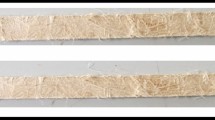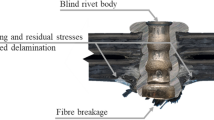Abstract
The thermal fatigue (TF) of ceramic matrix composites introduces stresses within the composite due to the thermal expansion mismatch of fibre and matrix; this will affect the lifetime and dimensional stability of the composite. A review of various laboratory TF methods is given, and the controlled, photon heating method used in this research is explained. A Nicalon fibre/glass matrix composite was subjected to rapid, controlled TF from 250 to 700 °C and 250 to 800 °C under no load and dead load conditions in order to illustrate a variety of elastic and inelastic cyclic strain conditions. To characterize simple environmental exposure at elevated temperature, ageing experiments were also run. After TF, the surfaces of the composites were characterized using SEM for evidence of thermal damage and microcracking. The composites were then tested for flexural strength. Results show that the tensile modulus after TF testing remains constant, and that dimensional changes are slight, except near any local hot spots. The 700 °C maximum TF specimens showed appreciably greater embrittlement and lower strength than the 800 °C maximum TF specimens. Observations in the SEM of the surfaces of the 700 °C specimens showed little matrix flow of the type which could decrease oxygen infiltration. Greater matrix flow was observed for the 800 °C specimens. Thermally aged specimens gave results similar to those for the TF experiments.
Similar content being viewed by others
References
G. R. Halford, M. A. McGaw, R. C. Bill andP. D. Fanti, “Bithermal Fatigue, A Link Between Isothermal and Thermomechanical Fatigue”, in ASTM STP 942, “Low cycle fatigue” (American Society for Testing and Materials, Philadelphia, Pennsylvania, 1988) p. 625.
C. F. Johnson andD. L. Hartsock, in “Thermal Response of Ceramic Turbine Stators in Ceramics for High Performance Applications”, edited by J. J. Burke, A. E. Gorum, and R. N. Katz (Brook Hill, Chestnut Hill, Massachusetts, 1974) p. 549.
G. D. Quinn, “Characterization of Turbine Ceramics After Long-Term Environmental Exposure”, AMMRC TR80-15 (1980): available NTIS, ADA17463.
J. Warren andB. Cowles, “A Simplified Thermomechanical Fatigue Test Method”, ASME, Paper Number 86- GT-20, January 1986.
C. Metzloff, “Hot Cell Testing”, in Proceedings of the High-Temperature Testing of Materials: 2 to 13 November 1986, Institute for Defense Analyses Memo Report M278, December 1986.
R. Warren, L. O. K. Larsson, P. Edstrom andT. Jansson, in “Progress in Science and Engineering of Composites”, edited by T. Hayashi, K. Kawada and S. Umekawa (Japanese Society for Composite Materials, Tokyo, 1982) pp. 1419.
M. A. H. Howes, “Evaluation of Thermal Fatigue Resistance of Metals using the Fluidized Bed Technique, Fatigue at Elevated Temperatures”, ASTM STP 520 (American Society for Testing and Materials, Philadelphia, Pennsylvania, 1973) pp. 242–54.
K. Nakano, L. Albingre, R. Pailler andJ. M. Quenisset,J. Mater. Sci. Lett.4 (1985) 1046.
G. A. Hartman, L. P. Zawada andS. M. Russ, “Techniques for Elevated Temperature Tensile Testing of Advanced Ceramic Composite Materials”, in Proceedings of the Fifth Annual Hostile Environment and High Temperature Measurements Conference, (Society for Experimental Mechanics Bethel, CT, 1988) pp. 31–8.
G. A. Hartman III,J. Test. Eval.13 (1985) 363.
J. R. Strife andJ. E. Sheehan,Amer. Ceram. Soc. Bull.67 (1988) 369.
K. M. Prewo, G. K. Layden, E. J. Minford andJ. J. B Rennan, “Advanced Characterization of SiC Fiber Reinforced Glass-Ceramic Matrix Composite”, ONR Report no. R85-916629-1 under ONR Contract No. N00014-81-C-0571, June 1985.
J. J. Brennan, “Interfacial Chemistry and Bonding in Fiber Reinforced Glass and Glass-Ceramic Matrix Composites”, in Ceramic Microstructures '86, MRS21, Ed J. A. Pask, A. G. Evens (Plenium Pub. 1987) 387.
T. Mah, M. G. Mendiratta, A. P. Katz andK. S. Masdiyasni,Amer. Ceram. Soc. Bull.66 (1987) 304.
T. Mah, M. Mendiratta, A. Katz, R. Ruh andK. Maxdiyasni,J. Amer. Ceram. Soc.68 (1985) 248.
R. L. Stewart, K. Chyung, M. P. Taylor andR. F. Cooper, in “Fracture Mechanics of Ceramics”, Vol. 7, edited by R. C. Bradtet al. (Plenum, New York, 1986) pp. 33–51.
J. F. Mandell, D. H. Grande andJ. Jacobs, “Tensile Behavior of Glass/Ceramic Composite Materials at Elevated Temperatures”, J. of Engineering for Gas Turbines and Power, Transactions of the ASTM,109 (1987) 267.
K. M. Prewo,J. Mater. Sci.22 (1987) 2695.
E. Bischoff, M. Ruhle, O. Sbaizero andA. G. Evans,J. Amer. Ceram. Soc.72 (1989) 741.
Author information
Authors and Affiliations
Rights and permissions
About this article
Cite this article
Zawada, L.P., Wetherhold, R.C. The effects of thermal fatigue on a SiC fibre/aluminosilicate glass composite. J Mater Sci 26, 648–654 (1991). https://doi.org/10.1007/BF00588299
Received:
Accepted:
Issue Date:
DOI: https://doi.org/10.1007/BF00588299




